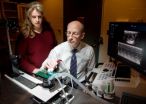APL is a rare, aggressive cancer of the blood and bone marrow that can be fatal in a matter of hours or days without prompt diagnosis and treatment. Thanks to the introduction of combination therapy with all-trans retinoic acid (ATRA) and anthracycline-based chemotherapy, APL has become a highly curable disease for patients in most developed countries. Although recent clinical trials conducted in the developed world have reported very high rates of complete remission (CR) and long-term disease-free survival (DFS) in patients treated with this regimen (90% achieving CR and 85% achieving DFS, respectively), this progress has not yet reached developing countries, where the reported long-term overall survival for patients with APL is below 60 percent.
Recognizing the need to increase APL survival rates in developing countries, in 2005 ASH founded the International Consortium on Acute Promyelocytic Leukemia (IC-APL). The goal of the IC-APL was to foster collaboration between researchers, clinicians, and laboratory scientists from institutions in developing countries and well-established international cooperative groups based in the United States and in Europe. Founding members of the initiative created the program with the hope that the resulting exchange of clinical expertise and support would ultimately improve the diagnosis and treatment of patients in developing countries with this often deadly hematologic malignancy.
"We chose APL as a model disease for the initiative because of the opportunity to improve patient outcomes in the developing world by collaborating with and learning from colleagues who have already successfully made these strides against this disease," said Eduardo Rego, MD, PhD, founding member of the IC-APL and Professor of Hematology/Oncology at the University of São Paulo in Brazil. "This initiative aims to build the capacity of local clinicians in the developing world to conduct clinical trials by introducing and fostering clinical and laboratory procedures that represent the standard of care for the treatment of acute leukemia in many countries around the world."
As part of the IC-APL, four transitioning countries – Brazil, Chile, Mexico, and Uruguay – were chosen to participate in a registry study modeling a clinical trial evaluating the efficacy and safety of a standard-of-care protocol for APL. During the registry study, which was governed by a panel of acute leukemia experts from Europe, Latin America, and the United States, medical representatives from each participating country received essential clinical trial administration training, including standard patient enrollment, data collection and reporting, administration of therapy, and outcomes reporting. Participants also attended regular face-to-face and online meetings with the expert panel to discuss progress and share data.
Following this extensive training, clinicians and scientists from the four participating countries began their registry trial, enrolling 183 adult patients with a suspected APL diagnosis between June 2006 and September 2010. An important change in the induction therapy protocol in the IC-APL registry study conducted in Brazil, Chile, Mexico, and Uruguay compared to regimens used in trials in developed countries was the replacement of the commonly used anthracycline idarubicin with the less expensive and more readily available drug daunorubicin. Patients enrolled in the trial received combination therapy including oral ATRA in two daily doses until complete remission and daunorubicin given intravenously on days 2, 4, 6, and 8. Throughout the trial, participating sites registered all cases using common clinical record forms in the Pediatric Oncology Network Database (POND) and collaborated with national clinical trial coordinators and reference laboratories to confirm the integrity and accuracy of treatment data.
After approximately three years of follow-up, investigators observed incredibly promising results: 80 percent of patients achieved two-year OS and 91 percent achieved DFS, all with a low cumulative incidence of relapse (4.5%). Early patient mortality (death occurring between diagnosis and first evaluation at 30 days) in the trial was reduced by nearly half compared to historical controls, and overall survival improved by 30 percent. Of the 180 evaluable patients that participated in the four host countries, 153 (85%) achieved complete remission.
After five years of follow-up, 75.4 percent of all patients enrolled and 90.2 percent of those who achieved CR remained alive. Early death occurred in 27 patients (15%). These rates of death are considerably lower than other population-based studies analyzing early mortality of APL patients conducted in the United States and Sweden (17.3% and 29%, respectively), further demonstrating the safety of this treatment combination. The most frequent hematologic toxicity was grade 4 neutropenia (low neutrophil count), which was observed in a small group (3.3%) of patients. No significant toxicities were reported during maintenance therapy and no secondary malignancies were reported. "In a very short time period, we observed an extraordinary increase in survival rates of our participants, who, before this trial, might not have had much hope for survival," said Dr. Rego.
The outstanding patient survival rates observed in the IC-APL trial demonstrate the efficacy of this affordable and readily available treatment protocol and are comparable to those observed in studies conducted in developed countries by both the Spanish group Programa para el Estudio de la Terapéutica en Hemopatía Maligna (PETHEMA, CR: 92.5% and 90%) and the North American Leukemia Intergroup (CR: 90%).
By refining and standardizing diagnostic procedures and implementing a standard-of-care treatment protocol, members of this innovative ASH collaborative have taken the first step toward significantly improving the prognosis of patients with severe and rapidly fatal diseases, such as APL, in developing countries using affordable and available treatments.
"Our initial success truly demonstrates that when we work closely with colleagues from around the world we can close the gap in treatment outcomes between patients in developed countries and those in developing countries. Our next challenge will be to improve the outcome of patients with other types of acute myeloid leukemias," added Dr. Rego, who also serves as the IC-APL's Brazilian national coordinator. "We are also expanding this initiative to additional countries, where we hope to further integrate education and networking and refine our treatment design to determine if we can achieve improved outcomes and possibly translate this model to other diseases."
Based on the initial success of the IC-APL, its governing body voted to expand the collaborative model to address other subtypes of acute leukemias, beginning with acute myeloid leukemia (AML). To reflect this change, the cooperative group is now called the International Consortium on Acute Leukemia (ICAL). For more information on ICAL, visit the ASH Global Programs website. ###
Blood (www.bloodjournal.org) the most cited peer-reviewed publication in the field of hematology, is available weekly in print and online. Blood is the official journal of the American Society of Hematology (ASH) (www.hematology.org), the world's largest professional society concerned with the causes and treatment of blood disorders.
ASH's mission is to further the understanding, diagnosis, treatment, and prevention of disorders affecting blood, bone marrow, and the immunologic, hemostatic, and vascular systems by promoting research, clinical care, education, training, and advocacy in hematology.
blood® is a registered trademark of the American Society of Hematology.



